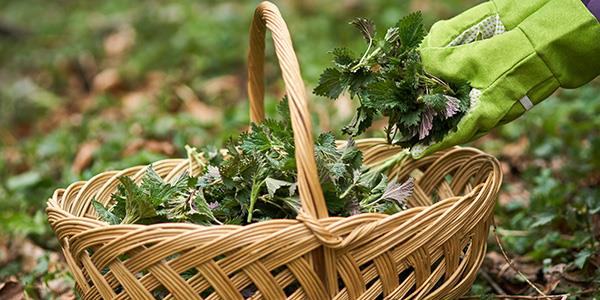The beginners’ guide to stinging nettles. All you need to know about where, when, what, why and how!
Nettles. We spent our youth fearing them; avoiding them while out walking, and being told not to touch them by our parents.
But now it seems we can’t get enough of these prickly little plants. Health shops, cafés and even supermarkets seem to be stocking up on nettle products, boasting their health benefits to all. But how much of it is true?
Why do nettles sting?
The majority of nettle varieties have little needle-like hairs that hook into your skin and release a burst of chemicals, including serotonin, formic acid and histamine. These cause the irritation to occur and the rash to form. It’s your body’s natural response to scratch it.

How to get hold of them
Nettles are pretty easy to identify. Their ovate leaves narrow to a point, almost the shape of an arrow head, and they have clearly serrated edges. When they flower during the spring and summer, the flowers form like catkins that hang in greenish clumps from the stems.
Nettles are a weed and they usually grow in patches, so if there is one plant, there are likely to be more around! Dock leaves (the nettle’s natural antidote) usually grow in very close proximity, so if you do happen to get stung whilst out foraging, don’t fear. It is thought that dock leaf sap contains an antihistamine which helps to soothe the affected skin, when rubbed over the area.
First of all, you need to get your hands on them. But before that… you need to put some gloves on! The sting is annoying but if you remember to wear impenetrable gloves and roll down your sleeves and wear long trousers you should be fine to pick at leisure. Wash the plants carefully and then drop them into boiling water. The stings are instantly rendered harmless.

What’s so great about nettles?
Why do people go through all the hassle of picking these pesky plants?
Taste: Once cooked, nettles taste like a mix between spinach and cucumber; fresh and wholesome. They make a great addition to dishes, adding a zing of flavour and a splash of colour. Nettle is great in sauces, risottos and soups.
Health: The nettle plant is full of nutrients that are really good for your health. They’re packed full of iron and vitamin C, magnesium and calcium. They have been used for years by different cultures.
Did you know?
Nettle has actually been used medicinally since at least 3 BCE! There is evidence their fibres have been used in textiles for 2,000 years and in the Medieval period nettle leaf was used in its raw form as a treatment for joint pain.
5 ways stinging nettles can benefit your health
Today, people are still using the nettles for similar health benefits, but we tend to know a lot more about why the plant is so useful.
1. Nettles can prevent you getting ill
Thanks to the iron, vitamin C and selenium, nettles give you a huge immune boost. Not only can that help fight against illnesses but can also give you an energy boost too, fighting fatigue and keeping your brain alert.
2. Nettles can benefit your circulation
The combination of vitamin C and iron is ideal for stimulating red blood cell production which helps your body’s circulation.
3. Nettles can help with joint pain
Because nettle tea is a diuretic it helps to remove excess uric acid which, in turn, helps to alleviate joint pain. There is also evidence that, when applied topically, the nettle helps to reduce the pain from calcium build up in joints (arthritis).
4. Nettles can help relieve stress
There is a high concentration of B vitamins in the nettle leaf which can be released when infused in hot water. The B vitamins are a good one to take for stress and help to balance the contributing chemicals. Nettle tea is therefore often drunk from relaxation.
5. It's been claimed that nettles are good for skin and hair
It’s been said that nettle can be good for hair and skin; it supposedly helps to combat symptoms of eczema and reduces the appearance of spots. Thanks to the nettle’s natural anti-inflammatory properties, this could well be true. The plant contains a lot of chlorophyll, as an alkaline, this helps to cleanse and detoxify cells.
How to use it
Nettle tea is really popular at the moment. It’s the simplest way of getting nettle into your body, but you can also cook it into larger dishes or even apply it topically if you have a skin irritation.
Because the stings have to remain firm to cause the irritation, cooking the leaf instantly makes them safe – don’t try to eat the leaf raw in a salad or anything. There are plenty of recipes online for a variety of hot dishes, so see what you fancy. Think of the nettle leaf like spinach and use it in a similar way.

The best place to try cooking nettles
A glamping trip is full of new experiences, so why not try cooking with nettles on a glamping trip? You'll have everything you need to experiment with new recipes in a glamping tent, with a kitchen hob and outdoor firepit supplied as standard. Book a glamping experience today.